Case #20: The U.S.-Enabled Genocide in East Timor, 1975‑1998
| revcom.us
Bob Avakian has written that one of three things that has “to happen in order for there to be real and lasting change for the better: People have to fully confront the actual history of this country and its role in the world up to today, and the terrible consequences of this.” (See “3 Things that have to happen in order for there to be real and lasting change for the better.”)
In that light, and in that spirit, “American Crime” is a regular feature of revcom.us. Each installment focuses on one of the 100 worst crimes committed by the U.S. rulers—out of countless bloody crimes they have carried out against people around the world, from the founding of the U.S. to the present day.
THE CRIME
The U.S.-backed Indonesian invasion and occupation of East Timor resulted in the worst slaughter relative to population since the Holocaust. From 1975 to 1999, the Indonesian military bombed, massacred, tortured, raped, and brutalized the population of East Timor until nearly one-third of the original population of 650,000 had been killed. During this time, the U.S. continually gave the military the economic and diplomatic support that enabled this horrific genocide.
Letters smuggled from East Timor spoke of the U.S.-supported horrors they faced:
“Many elements of the population were killed under inhuman conditions of bombardment and starvation.... The waters of the river were filled with blood and bodies. Husbands, fathers, brothers and abandoned wives, sons and brothers all in the same agony.”
“The mountains shake with the bombardment. The earth talks with the blood of the people, who die miserably....”
“Tell my son that for nothing on this earth should he return to Timor. I would rather die without seeing him again than to know he had returned to this hell.”
East Timor is half of a small island, located between Australia and Indonesia. It was colonized by Portugal in the 1500s, which held the territory until April 1974, when a new government began the process of decolonization. Indonesia, ruled by a brutal military dictatorship that had come to power through a U.S.-sponsored coup in 1965, immediately began planning to take over East Timor. The U.S. repeatedly gave its OK to Indonesia for a full-scale invasion. President Gerald Ford and Secretary of State Henry Kissinger even paid a formal visit to the capital, Jakarta, and reaffirmed U.S. support immediately before the invasion. Ford told the military dictator Suharto, “We understand the problem you have and the intentions you have.” Privately, U.S. officials told the Indonesians to invade “effectively and quickly,” with the CIA advocating the use of “overwhelming force,” and the U.S. doubled its military aid to ensure that this would happen. The main problem, as U.S. officials saw it, was how to get around various U.S. laws that the U.S. was about to violate with its support of international aggression.
On December 7, 1975, the invasion of East Timor began, an attack that one historian characterized as “one of the most brutal operations of its kind in modern warfare.” Within months, the death toll was up to 60,000, while hundreds of thousands more fled into the mountains. The U.S. later claimed to have cut off arms sales following the invasion, but in reality it went out of its way to supply special weaponry to the Indonesians. Philip Liechty, the CIA station chief in Jakarta at the time, later stated that the U.S. tried to get as many weapons to Indonesia as quickly as it could out of fear that if the public found out about what was going on, the flow of weapons might be cut off.
The U.S. stifled international criticism of the invasion to prevent anyone from coming to the aid of the Timorese. At the time, East Timor was still under Portuguese rule but the U.S. told Portugal (a NATO country) that it was not allowed to defend the people of East Timor from the invasion.
U.S. Ambassador to the UN Daniel Moynihan later bluntly stated that he was instructed to “render the UN utterly ineffective,” adding that the “United States wished things to turn out as they did [regarding UN inaction] and worked to bring this about.” The UN did not get involved again until after the Indonesian dictatorship was overthrown in 1998.
Despite receiving no outside assistance, the Timorese resistance was popular and well-organized, fighting the invaders to a stalemate. After two years of unrelenting warfare, Indonesia began to run out of ammunition and weapons. The U.S. stepped in to sell massive amounts of weaponry, while doubling military aid (all of which, again, violated U.S. laws). Fully equipped, Indonesia launched a massive offensive in September 1977. Indonesian planes, reportedly aided by U.S. pilots and mercenaries, began daily saturation bombing of the interior, aided by defoliants, napalm, and chemical and biological weapons. This was combined with continuous large-scale ground assaults and a deliberate policy of starvation through a scorched earth campaign and the destruction of the agricultural system.
A letter from a Timorese captured the horror being rained down:
The bombers did not stop all day. Hundreds of human beings died every day. The bodies of the victims become food for carnivorous birds. If we don’t die of the war, we die of the plague; villages have been completely destroyed, some tribes decimated. The barbarities, the cruelties, the pillaging, the unqualified destruction of Timor, the executions without reason have spread deep roots in Timor. Genocide will come soon....
The brutal offensive forced most Timorese down from the mountains, where they were put into hundreds of concentration camps built with money from USAID and modeled on the “strategic hamlets” used by the U.S. in Vietnam. Prevented from farming and kept in malaria-infested lowlands, famine and disease spread through the camps and throughout the rest of the country as well. Though the U.S. knew the extent of the famine, they conspired with the Indonesians to prevent any relief aid from being delivered until after the offensive was over. As a result, tens of thousands died of starvation and disease.
In addition to the weapons sales, the U.S. trained many of the officers who led the fighting in East Timor. One U.S.-trained elite unit, called Kopassus, became known in East Timor as the nangalla, or “knife-wielding killers.” The U.S. also ensured that billions of dollars in economic aid were funneled annually to the Indonesian dictatorship through the World Bank and IMF.
For these 25 years the U.S. gave continuous support to what is arguably the worst invasion and mass slaughter since World War 2, all the while knowing exactly what was going on. Philip Liechty, the CIA officer mentioned earlier, stated:
I saw the intelligence that came from firm sources. There were people being herded into school buildings by Indonesian soldiers and the buildings set on fire; anyone trying to get out was shot. There were people herded into fields and machine-gunned. We knew the place was a free-fire zone ... Without the continued heavy U.S. logistical military support the Indonesians might not have been able to pull it off. They were able to stay there at no real cost to them; it didn’t put any pressure on their economy and on their military forces because American taxpayers were footing the bill for the killing of all those people and for the acquisition of that territory, to which they had no right whatsoever. We were providing most of the weaponry, helicopters, logistical support ... all of the expendables the Indonesians needed to conduct this war. Why not just leave the Timorese alone?
East Timorese resistance and guerrilla struggle continued in various forms over the next two decades, but the people of East Timor continued to live in a situation of terror. Smuggled photographs and captured Indonesian military manuals showed that unspeakable torture was routine, as were disappearances, long-term imprisonment, massacres of protesters, and rape and sterilization of Timorese women. As one Timorese put it in 1994; “We the people in East Timor call it the biggest prison island in the world. You must understand that. For us who live here, it’s hell.” By 1998-99 the global terrain had shifted and Suharto was forced to resign, in part due to large-scale protests.
Despite a U.S.-backed terror campaign against them, which included an April 1999 massacre of 200 people who were seeking refuge at a church, the East Timorese voted overwhelmingly for independence in an August 1999 referendum. After the vote, the Indonesian military, along with paramilitaries they organized, went on a pre-planned, weeks-long rampage of murder and destruction which forced hundreds of thousands of East Timorese into detention camps. While this massive pogrom was taking place, the U.S. blocked international action to stop it. After it ended, East Timor was occupied by an “international peacekeeping force.” When East Timor finally gained independence in May 2002, the country had been largely destroyed, and its people were still suffering the effects of decades of unspeakable horrors.
THE CRIMINALS
President Gerald Ford personally assured the Indonesian dictator Suharto of U.S. support for the invasion. The Indonesians were extremely concerned about what the U.S. response to an invasion would be and repeatedly sought approval in the months leading up to it from officials from the State Department, the CIA, and U.S. Congress.
President Jimmy Carter oversaw and supported the 1977 shift from aggression to genocide. His vice president, Walter Mondale, even flew to Indonesia to make unsolicited offers of weaponry specifically designed for the conditions the Indonesians were facing in East Timor. And during Carter’s administration, the U.S. prevented the International Red Cross from entering East Timor, even though it knew of the catastrophic famines there.
President Ronald Reagan continued U.S. backing, selling nearly a billion dollars in weaponry, including in 1983 when the East Timorese resistance had forced the Indonesians to sign a cease-fire.
President George H.W. Bush continued American support and, if anything, was the most enthusiastic about it. When video footage of the Indonesian military massacring hundreds of nonviolent demonstrators was seen around the world in 1991, the White House response was to ask Congress for an increase in military aid to Indonesia.
When there was finally a referendum on East Timor’s future, in 1999, the administration of President Bill Clinton insisted on the disarming of independence fighters even though they knew that Indonesia planned on destroying the country if the Timorese voted for independence. Following that vote, the Indonesian military went on a rampage of murder and destruction for weeks while the U.S. blocked international action. When East Timor finally became independent, the country was largely destroyed and its people suffered the effects of being subjected to unspeakable horrors.
Gen. Suharto, Indonesia’s ruler, and his generals such as Benny Murdani and Wiranto were directly responsible for the genocide, while officials like Foreign Minister Ali Alatas did the work of whitewashing it to the world.
THE ALIBI
The U.S. claimed Fretilin (the Revolutionary Front for an Independent East Timor), which led the Timorese resistance, were communists out to destabilize Indonesia and the region. (In reality, there was no communist party in East Timor and Fretilin was open to being subordinate to Indonesia.) The U.S. also claimed Fretilin were no more than “desperate terrorists” responsible for “pillaging villages [and] murdering people.” The U.S. even claimed that Fretilin was responsible for the famines and that they had “turned the country into a wasteland.”
For the most part, however, the U.S. ruling classes were virtually unanimous on supporting the occupation, and on keeping quiet about it. As Florida Republican Congressman J. Herbert Burke, then ranking minority member of the House subcommittee on Asian and Pacific Affairs, put it: “It is in all our interests to bury the Timor issue quickly and completely.” No U.S. president ever gave a public statement on the genocide or in any other way worked to bring public attention to it. Coverage in the New York Times, Washington Post, Time magazine and other media almost entirely disappeared as the violence reached genocidal proportions.
THE ACTUAL MOTIVE
With its huge population and strategic location, Indonesia had long had an important role to play for U.S. imperialism in the region. Following WW2, the U.S. identified Indonesia as part of a “Grand Area” whose role was to be a stable source of raw materials and cheap labor for the U.S., Japan, and other nations. The sheer size of this country of 200 million people—fourth largest in the world—means that what happens there has a profound impact on the whole region. The Pentagon has expressed much concern about instability in Indonesia—both because of the international shipping lanes that go through Indonesian waters and because the country has the world’s largest Muslim population.
At the time of the invasion, the U.S. was facing a new situation, both locally in Southeast Asia and in the world as a whole. The U.S. had been defeated in Vietnam and had been knocked back on its heels in southern Asia. When Ford and Kissinger met with Suharto before the invasion, they were concerned with the possible spread of liberation struggles and Soviet influence in the region.
The Indonesian military was facing its own necessity, which the U.S. was very cognizant of. Indonesia is made up of thousands of islands, and though dominated by the Javanese it consists of many different nationalities, some of which have desires for independence. The Indonesian rulers invaded and used the most brutal violence in East Timor in part to send a message to all the other nationalities of Indonesia that separatist movements will be crushed. Indeed, the East Timorese struggle for independence was one of the sources of inspiration for protesters when Suharto was overthrown in 1998.
The U.S. supported the occupation primarily because it wanted to ensure the continued existence of the pro-U.S. government in Indonesia and strengthen its role as an essential geo-political cornerstone for U.S. imperialism in the region. Secondarily, as a State Department official stated shortly after the invasion, Indonesia “is a country we do a lot of business with.” As for the people of East Timor, the U.S. simply did not care what happened to them. One of the architects of U.S. policy, Henry Kissinger, once put it, East Timor “was not a big thing on our radar screen.” Kissinger, it should be noted, made this comment to a Timorese who had lost countless friends and relatives to the occupation.
Sources
Budiardjo, Carmel and Liem Soei Liong. The War Against East Timor, London: Zed, 1984.
Burr, William, and Michael L. Evans, eds. East Timor Revisited: Ford, Kissinger and the Indonesian Invasion, 1975-76, National Security Archive, Washington, D.C., 2001.
Chomsky, Noam and Edward S. Hermann. The Washington Connection and Third World Fascism. New York: Spokesman Books, 1979.
Dunn, James. Timor: A People Betrayed, Milton, Qld: Jacaranda, 1983.
Nevins, Joseph. A Not-So-Distant Horror: Mass Violence in East Timor. Cornell University Press, 2005.
Retbøll, T. and T. Aparicio. East Timor, Indonesia and the Western Democracies: a Collection of Documents. Copenhagen: Documentation Department of IWGIA, 1979.
Taylor, John G. Indonesia’s Forgotten War: The Hidden History of East Timor. New Jersey: Zed Books, 1994.
Turner, Michelle. Telling: East Timor, Personal Testimonies, 1942-1992. Kensington, NSW, Australia: New South Wales University Press, 1992.
“U.S. on East Timor: Hypocritical Tears and Imperialist Concerns,” revcom.us, September 19, 1999.
American Crime “Case #100: 1965 Massacre in Indonesia,” revcom.us, October 20, 2017.
“East Timor ‒ Profile,” BBC, February 26, 2018.
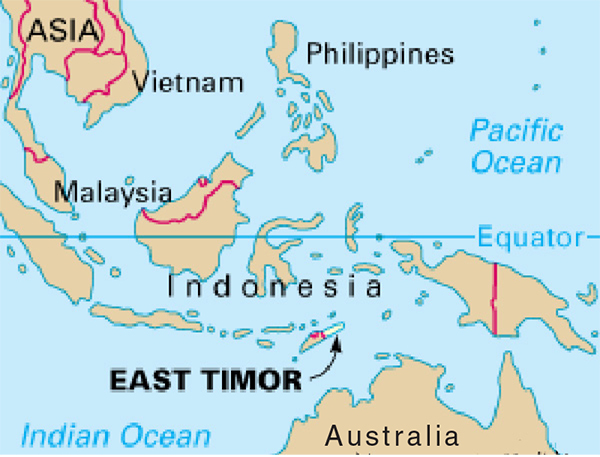
East Timor is half of a small island, located between Australia and Indonesia.
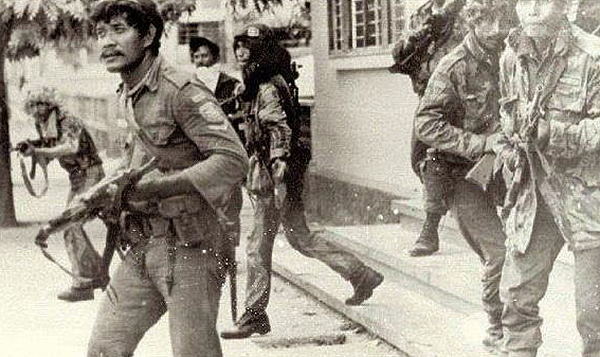
U.S. officials told the Indonesians to invade “effectively and quickly,” with the CIA advocating the use of “overwhelming force.” The U.S. doubled its military aid to ensure that this would happen. Above, members of the Indonesian army.

From 1975 to 1999, the Indonesian military bombed, massacred, tortured, raped, and brutalized the population of East Timor until nearly one-third of the original population of 650,000 had been killed. The U.S. continually gave the military the economic and diplomatic support that enabled this horrific genocide.
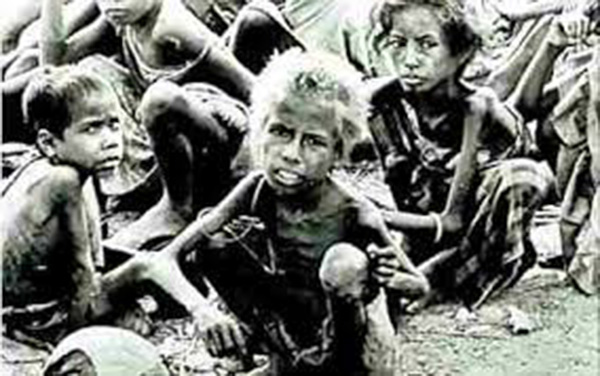
A letter from a Timorese: “Hundreds of human beings died every day. The bodies of the victims become food for carnivorous birds. If we don’t die of the war, we die of the plague; villages have been completely destroyed, some tribes decimated.... Genocide will come soon....“. Above Timorese children in 1975.
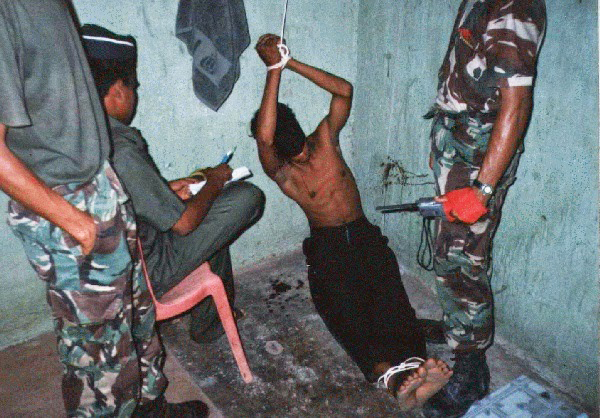
Fretilin (the Revolutionary Front for an Independent East Timor) who led the resistance against the invasion by Indonesia were labeled terrorists and tortured.
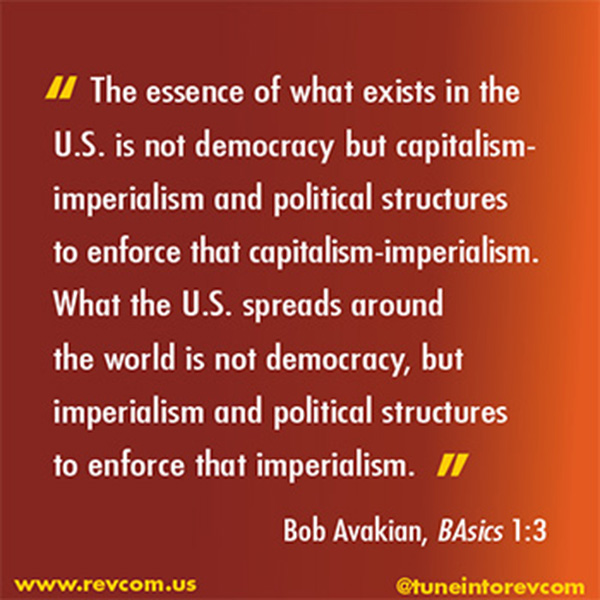
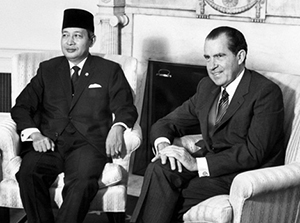
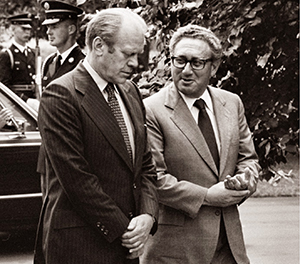
Left: Indonesian dictator Suharto with Nixon. Right: Ford, who personally assured Suharto the U.S. would support his invasion of East Timor, with Henry Kissinger.
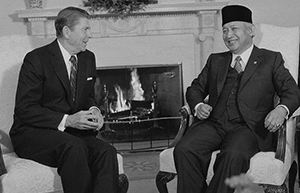

Left: Reagan and Suharto. Reagan sold Indonesia nearly a billion dollars worth of weaponry. Right: Suharto and Clinton. In 1999 when East Timor finally held a referendum on its future, Clinton insisted on disarming of independence fighters even though they knew that Indonesia planned on destroying the country if the Timorese voted for independence.
Get a free email subscription to revcom.us:


